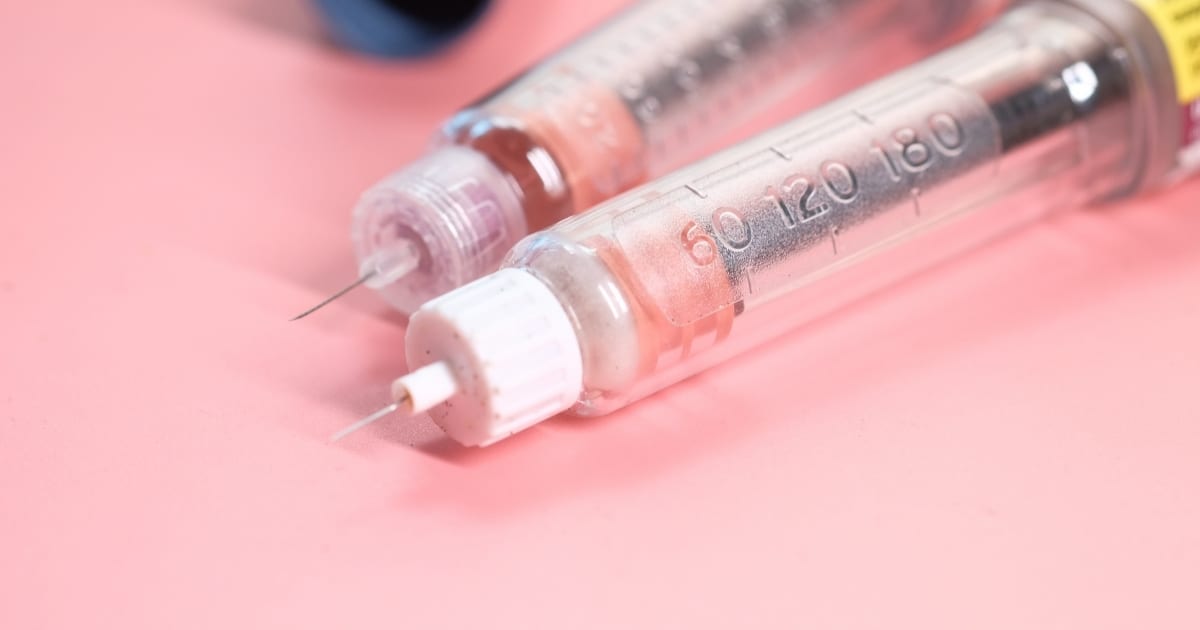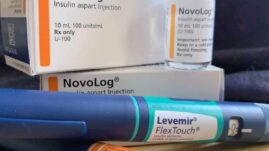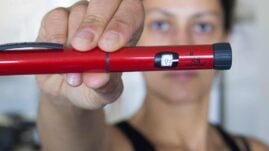If you live with insulin-dependent diabetes and manage your blood sugars with an insulin pen or syringe, you’re most likely taking 2 or more insulin shots a day.
That’s a minimum of 730 times a year that you’re piercing your skin with a needle to do an injection.
I do a lot more than 2 injections a day. I’m closer to 7 doses a day, which isn’t unusual for people living with diabetes. That’s 2,555 injections a year!
I don’t mind and it doesn’t hurt. But one of the main reasons it doesn’t hurt is that I use the right needle, the right injection technique, and I change my needles frequently.
In this article, you’ll learn how to choose the needle or syringe size that’s right for you to minimize pain, avoid scar tissue buildup, and ensure that a full dose is received every time you inject.

What is a pen needle?
Pen needles are needles that you attach to a prefilled or durable pen so that you can inject the medication.
Common types of pen needles include standard pen needles and safety pen needles, with most people using a standard pen needle.
You can watch this 1-minute video to see exactly what a pen needle is:
A standard pen needle has an outer cover and a removable inner needle cover. Both need to be removed before insulin flows.
Unfortunately, due to poor training, not everyone has been taught that you need to remove both covers. According to the FDA, this has led to people ending up with severely elevated blood sugars and even hospitalizations. So remember to remove both covers and visually ensure that insulin is flowing.
The safety needle is a little different. It has an outer cover that’s removed before injections, but the inner cover isn’t removed. When you push the safety needle into your skin, the inner cover slides back to reveal the needle.
Because the inner cover isn’t removed, it protects you against accidentally poking yourself with the needle.
This type of needle is ideal if you’re scared of needles (as you’ll never see the actual needle) or if there is a concern that you’ll accidentally poke yourself with the needle.
Pen needle sizes
Insulin pen needles are available in different sizes from 4 mm to 12.7 mm in length (5/32 inch to ½ inch).

Generally, the medical community leans towards the use of shorter needles, but you ultimately need to decide which needle size is right for you.
Being prescribed a longer needle can make that initial insulin injection somewhat daunting and might even impact your desire to take your injections as prescribed.
If that’s the case, please reach out to your doctor and request a different needle, or if you’re in a state that doesn’t require a prescription (more on that later), purchase a size that suits you online or at your local pharmacy.
How do you know what size insulin needle to use?
Insulin and GLP-1s need to be injected subcutaneously (into the fat between your skin and your muscle) so you should choose a needle that allows you to do that the easiest.
On average, human skin is 1.9–2.4 mm thick regardless of body size, gender, ethnicity, and BMI. This means that a short 4- or 5-mm needle should be effective for all body types.
The International Scientific Advisory Board states that there is no medical reason to recommend a needle length longer than 8 mm. The board recommends 4-, 5-, and 6-mm needles for all adult patients regardless of their BMI.
That doesn’t mean you can’t use a longer needle, but using a longer needle can increase the chances of bruising, bleeding, and pain.
When using a longer needle, you also risk injecting your insulin into the muscle (called an intramuscular shot). If insulin is injected into the muscle instead of the fatty tissue, absorption can be too rapid which can lead to low blood sugars.
Although shorter needles are generally recommended, there are certain circumstances where a longer needle may be a better option.
For example, you may benefit from using a longer needle If you have coordination challenges from conditions such as arthritis or Parkinson’s disease.
Needle thickness – What’s the deal?
Needle thickness is measured in gauge (G) rather than millimeters or inches. Pen needles come in 29 G to 32 G, and the higher the gauge, the thinner the needle.
The pen needle thickness is mainly relevant if you inject a large amount of insulin at a time, as you might want a needle with a lower gauge that will allow more insulin to flow through faster.
When to pinch the skin
There are different ways of successfully doing a subcutaneous injection and the right technique comes down to what length of needle you choose.
If your needle is 4 mm or 5 mm, you can do the injection at a 90-degree angle. That means you don’t need to pinch the skin, and you can do the injection one-handed if you like. This can be practical if you’re injecting into the arm, lower back, or glutes.
Children from 2 to 6 years old or extremely lean adults may need to use a pinch-up technique regardless of needle length.
If you opt for a needle longer than 5 mm, you will want to do the injection with a pinched-up skinfold or a 45-degree angle to avoid intramuscular injection of insulin.
What about leakage concerns related to shorter needles?
Some people have raised the concern that short needles will lead to leakage (insulin not being fully injected) or that they aren’t suitable for people with larger bodies.
That concern has been debunked and research has shown that shorter needles work for most body types, with no additional leakage.
But if you feel more comfortable using a longer needle, then you should absolutely do that.
How to get your pen needles or syringes
You might wonder if you can buy pen needles over the counter, and the short answer is that it depends.
In the United States, prescription rules differ from state to state and in some states, you don’t need a prescription to buy pen needles.
However, if you use your insurance to pay for your needles, they might require a prescription. Reach out to your insurance company to learn if you need a prescription and if so, how much your co-pay is.
There are also options to buy pen needles online without a prescription, but which solution is most cost-effective for you will depend on your insurance.
How to choose the right insulin syringe?
Using a syringe for your insulin injections is still the most widely used way of delivering insulin in the United States.
A syringe is a hollow plastic tube with a plunger inside and a short skinny needle attached. You have to use the syringe to draw the insulin out of a vial and then inject it.
You want to choose the right syringe for the type of insulin that you use, and the first thing to check is if the concentration of your insulin matches the syringe.
It’s indicated on the syringe (as well as on the packaging) what insulin concentration the syringe is for. Insulin concentration is measured in Units/mL and indicated as U-100, U-200, or U-500.
Make sure your syringe matches your insulin concentration or you might end up injecting the wrong amount of insulin.
Secondly, you want to choose the syringe size that’s appropriate for you. If you use large amounts of insulin at a time, you’ll want to choose a larger syringe so that you don’t have to cut your doses up into smaller amounts.
- 0.3 mL syringes are for doses under 30 units of insulin and are numbered at 1-unit intervals.
- 0.5 mL syringes are for doses of 30 to 50 units of insulin and are numbered at 1-unit intervals.
- 1.0 mL syringes are for doses of more than 50 units of insulin and are numbered at 2-unit intervals.
Finally, you want to consider which size needle is appropriate for you. Just as with pen needles, shorter needle sizes are generally recommended.
You can get syringes with needles as long as 12.7 mm (1/2”) long but the shortest syringe needle length available is 6 mm (15/64”) x 31G.
Good injection practices
Choosing the needle or syringe that works for you is important, but injections will be more comfortable with less risk of pain or leakage if you also remember to:
- Change the needle every time.
- Choose the right injection site and rotate your sites.
- Don’t jab the needle in
- Hold it in for 5 to 10 seconds to reduce the risk of leakage.
If you choose the right needle size and follow good injection practices, injecting insulin should rarely be painful. When you are done with your pen needle or syringe, please remember to dispose of them safely.




David Bell
Although medics always say to use a new needle at each injection I only use one needle per day with no downside e.g bruising, pain etc. Some may need to change needles but if you don’t you save cost using one or so a day.
John Marshall
This article was very helpful because I am switching from syringes to a pen and had no idea how a pen works or what was the best needle to request. Hate to admit it but I’m cheap and I use one syringe for my 3 daily shots of fast acting and one syringe for two days worth of the slow acting. True, my belly looks like I was run over by a bike but otherwise no problem.
R.J Forster
Please do one about the best pens. In BC Canada they’ve switched us over to generic biosimilars. Problem is the old pens don’t work and I prefer them much better. Mostly because you can count the clicks. But the quality was much better. The Lilly ones were superior with the novo nordisk* a close second but a little smaller and lighter. I broke one of those in my pocket doing heavy lifting but that was my fault.
The Savvio and Allstar ones I don’t like nearly as much.
Christel Oerum
Oh no, that’s unfortunate. Sorry to hear that ? We do have an insulin pen post in the pipeline but the focus is mainly on the options available
Soma Golden Behr
Could you Evaluate the echo pen. I find that the memory function, which is the most important thing in the pen for me, malfunctions frequently. I returned 4-5 to maker and they’ve given me a new one at no charge. I’m losing faith in the general reliability of Echo.
I’d like to hav a pen respond with accurate shots for my quick insulin, FIASP. I use Tresiba in à prefilled blue pen— is that kind of pen available for a fast indd as youn in vials? —what pen does best job?
Christel Oerum
I haven’t used the Echo pen for year. I’m not sure how to get my hands on one, but if I could I wouldn’t mind testing it out
henry miles
Excellent article, You have summerised important points, keep it up. Thank you
Amresh Singh
I was not knowing how to use an insulin pen. I used to apply on the stomach and sometimes on the thighs. It worked wonders. It brought my sugar level to normal. But this article has cleared many of my doubts regarding the use. i will show this to my doctor and other diabetic people. Thanks a lot!
Dave
Keep in mind that if you have scare tissue or are trying to avoid scare tissue… there is now inhaled insulin. Injectable insulin isn’t for everyone.. it’s 100 years old and it’s all most know about.
Time to upgrade!
Christel Oerum
I do like Afrezza (https://diabetesstrong.com/inhaled-insulin-afrezza/) but it’s not an option for everyone and is not widely available outside the US